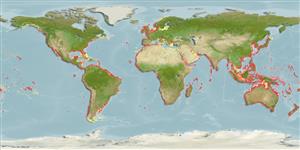Common names from other countries
Classification / Names / Names
Populaire namen | Synoniemen | Catalog of Fishes (gen., sp.) | ITIS | CoL | WoRMS
Environment: milieu / climate zone / depth range / distribution range
Ecologie
; diepteverspreiding 0 - 37 m (Ref. 102166). Subtropical
Atlantic, Mediterranean and Indo-Pacific oceans: from USA to Uruguay including Gulf of Mexico and the Caribbean, east to Norway and south to Namibia including the Mediterranean; from the Arabian Sea, including Persian Gulf, Oman Sea and the Red Sea, south to Tanzania including Seychelles, east to India and south to Western Australia, including Andaman Sea; from Japan to the South China Sea, south to New Zealand, Hawaii and Chile.
Length at first maturity / Size / Gewicht / Leeftijd
Maturity: Lm ? range ? - ? cm Max length : 1.0 cm H mannelijk/geslacht niet bekend; (Ref. 80701)
Turf formation in the upper intertidal, blackish-red colour when slightly dry, and extensive rhizoids (Ref. 80701). On rock in upper intertidal forming extensive mat-like growths below Pelvetia canaliculata, particularly on vertical or near-vertical surfaces. Sometimes associated with Catenella caespitosa and Rhodothamniella purpurea. Widely distributed, common (Ref. 80701). Also on volcanic rocks at shallow intertidal to subtidal depths (Ref. 80999).
Guiry, M.D. and G.M. Guiry. 2009. (Ref. 80701)
Status op de Rode Lijst van het IUCN (Ref. 130435)
Status bij CITES (Ref. 108899)
Not Evaluated
Not Evaluated
Gebruik door de mens
| FishSource |
Tools
Meer informatie
Leeftijd/Grootte
Groei
Lengte-gewicht parameters
Lengte-lengte parameters
Morfologie
Larven
Abundantie
Internet-bronnen
Estimates based on models
Preferred temperature
(Ref.
115969): 10.7 - 29.1, mean 26.9 (based on 7544 cells).
